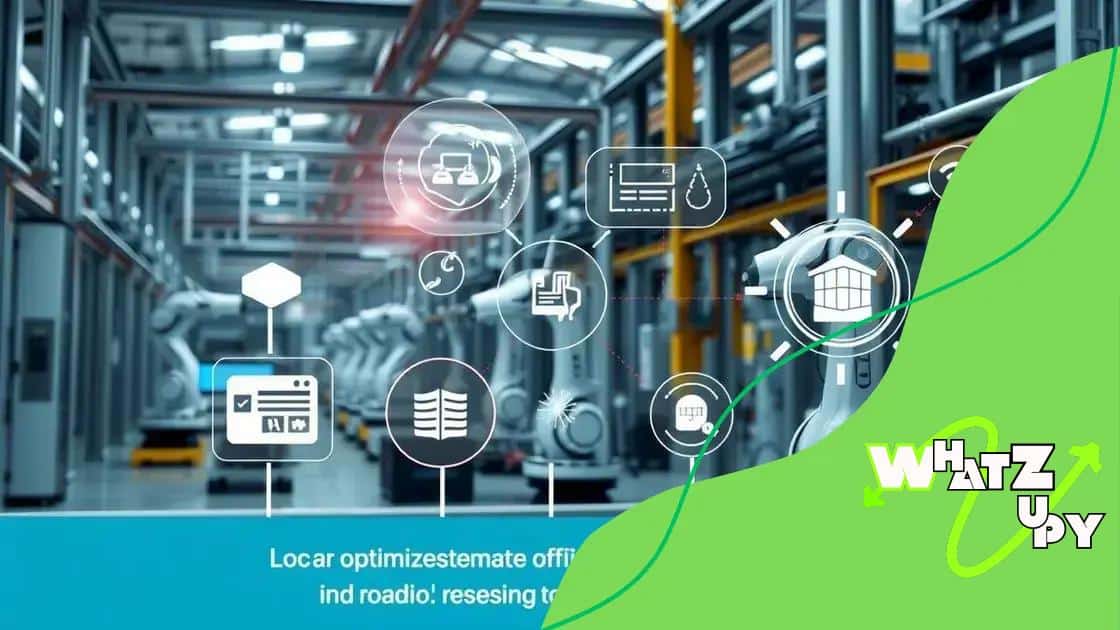Reinforcement learning transforming robotics and automation

Reinforcement learning is revolutionizing robotics by enabling machines to learn from their environments, adapt their behaviors, and perform complex tasks with increased efficiency across various industries.
Reinforcement learning transforming robotics and automation is reshaping how machines learn and adapt. Have you wondered how this technology enhances efficiency and decision-making in various fields? Let’s dive into the details.
Understanding reinforcement learning in robotics
Understanding reinforcement learning in robotics is essential for grasping how machines can learn from their environments. It allows robots to make decisions based on experience rather than programming alone. As technology advances, this learning technique has become key in developing smarter and more efficient robots.
When we look at reinforcement learning, there are some critical components to consider. It involves an agent, the environment, actions, and rewards. The agent interacts with the environment by taking actions. Each action results in a reward or penalty, guiding the agent toward better performance over time.
Key Components of Reinforcement Learning
- Agent: The entity (robot) that learns and makes decisions.
- Environment: Everything the agent interacts with, including tasks and obstacles.
- Actions: The choices that the agent can make in the environment.
- Rewards: Feedback that helps the agent learn which actions are favorable.
Another interesting aspect of reinforcement learning is the way these machines can adapt. As they gather more data from their interactions, they refine their actions and improve continually. For instance, a robot programmed to navigate through obstacles will initially struggle but will become more adept through trial and error. This ability to learn and adapt sets robots apart from traditional programmed machines.
Moreover, reinforcement learning enhances automation across industries. From manufacturing to healthcare, robots using this technology can optimize processes effectively. This capability not only boosts productivity but also helps in performing complex tasks with precision.
Applications of reinforcement learning in automation
Applications of reinforcement learning in automation have transformed how industries operate, making processes smarter and more efficient. This powerful technology enables machines to learn from their environment and improve their decision-making over time.
In manufacturing, robots powered by reinforcement learning can adapt to changing assembly line conditions. They learn from their mistakes and successes, which allows them to optimize production schedules and reduce downtime. For example, a robot may initially struggle to pick up parts, but through repeated attempts and adjustments based on feedback, it becomes more proficient.
Key Areas of Application
- Industrial Robotics: Robots that learn to perform complex tasks on production lines.
- Logistics and Supply Chain: Automated systems that efficiently manage inventory and deliveries.
- Autonomous Vehicles: Cars and drones using reinforcement learning for navigation and obstacle avoidance.
- Smart Manufacturing: Systems that optimize operations based on real-time data.
Another exciting application is in the field of logistics and supply chain management. Here, reinforcement learning helps automate processes such as inventory management and real-time routing. These systems learn from past decisions to improve future efficiency. A warehouse robot, for instance, can continuously update its routes to find the fastest way to gather items.
Furthermore, autonomous vehicles are rapidly evolving thanks to reinforcement learning. These vehicles learn to navigate complex environments and make real-time decisions. They improve their driving skills by continuously receiving input from various sensors, which helps them understand their surroundings better.
In smart manufacturing, reinforcement learning applications are revolutionizing production efficiency. Automated machines can assess performance through data analysis, allowing them to make necessary adjustments autonomously. This shift leads to less waste, higher quality products, and significant cost savings.
Benefits of reinforcement learning for efficiency

The benefits of reinforcement learning for efficiency are substantial in various fields. This technique allows machines to learn from their environment, leading to improved performance and productivity. By adapting to new situations, systems can operate more intelligently over time.
One of the main advantages of using reinforcement learning is its ability to optimize processes. For instance, in manufacturing, machines learn to adjust their operations based on real-time feedback. As the system gathers data about its performance, it makes necessary changes that enhance outcomes, such as reducing errors and increasing output.
Key Benefits of Reinforcement Learning
- Continuous improvement: Systems evolve with ongoing learning, becoming more efficient over time.
- Increased automation: Less human intervention is needed as machines learn to manage tasks independently.
- Real-time decision making: Robots can adapt quickly to changing conditions, improving responsiveness.
- Enhanced resource management: Machines optimize their use of materials and energy, reducing waste.
Another significant benefit is that reinforcement learning leads to smarter resource management. In logistics, for example, autonomous vehicles use this technology to optimize routes and reduce fuel consumption. They learn from traffic patterns and adjust their paths accordingly, which saves time and costs.
Moreover, the implementation of reinforcement learning in customer service has transformed efficiency as well. Chatbots and automated responses learn from interactions, improving their ability to resolve issues correctly and faster. This process increases customer satisfaction while reducing workload on human employees.
Overall, the capabilities of reinforcement learning are revolutionizing how businesses operate. By continuously improving and adapting, these systems not only enhance efficiency but also pave the way for innovative solutions across many industries.
Challenges in implementing reinforcement learning
Implementing reinforcement learning comes with several challenges that organizations must address. These challenges can affect the efficiency and success of the technology in real-world applications. Understanding these obstacles is essential for companies looking to adopt this innovative approach.
One major challenge is the need for extensive training data. Reinforcement learning relies heavily on interactions between the agent and the environment. This process often requires vast amounts of data to ensure that the system learns effectively. Gathering this data can be time-consuming and resource-intensive.
Key Challenges in Implementation
- Data Requirements: Large datasets are needed for effective training.
- Computational Resources: High processing power is necessary for complex algorithms.
- Real-World Variability: Real-world environments can be unpredictable, complicating learning.
- Safety and Reliability: Ensuring that learned behaviors are safe is crucial.
Another significant challenge is the computational resources needed for training reinforcement learning models. The algorithms can be demanding, especially when dealing with high-dimensional data. Companies may need to invest in advanced hardware or cloud computing solutions to meet these requirements.
Furthermore, real-world variability presents a challenge. Unlike simulated environments, real-world scenarios can change rapidly. This unpredictability can hinder the learning process, making it difficult for the agent to generalize experiences. Training in a stable environment before deployment is often necessary but not always feasible.
Lastly, ensuring the safety and reliability of these systems remains a primary concern. As robots and automated systems learn from their environment, they may develop behaviors that are unintended or harmful. Therefore, it is crucial to have monitoring systems in place to provide feedback and prevent dangerous outcomes.
Future of robotics with reinforcement learning
The future of robotics with reinforcement learning is bright and filled with possibilities. As technology advances, machines will become more capable of learning on their own. This shift will lead to greater autonomy and improved efficiencies across various sectors.
One exciting aspect of this future is the potential for robots to perform complex tasks seamlessly. Through reinforcement learning, robots can develop skills over time, learning from each experience. This ability to adapt and improve makes them invaluable in fields such as healthcare, logistics, and agriculture.
Predicted Developments in Robotics
- Enhanced Collaboration: Robots will work alongside humans more effectively, learning to complement human efforts.
- Increased Autonomy: Machines will perform tasks with little to no human intervention.
- Real-Time Learning: Robots will adapt their behavior based on immediate feedback from their environment.
- Broadened Applications: From home assistance to space exploration, applications will expand significantly.
Moreover, the integration of reinforcement learning into robotics will enhance their ability to navigate dynamic environments. Autonomous vehicles, for example, will rely on this technology to make real-time decisions, improving safety and efficiency on the roads.
In the realm of healthcare, robots will learn to assist in surgeries and patient care. They will adapt to individual patient needs, ultimately improving the quality of care. This personalized approach could revolutionize how medical procedures are performed.
As robotics continues to evolve alongside reinforcement learning, the possibilities are limitless. The combination of these technologies will create smarter, more efficient machines that are capable of transforming industries and enhancing daily life.
FAQ – Frequently Asked Questions About Reinforcement Learning and Robotics
What is reinforcement learning?
Reinforcement learning is a type of machine learning where agents learn to make decisions by receiving rewards or penalties based on their actions.
How does reinforcement learning improve robotics?
Reinforcement learning allows robots to adapt their behavior based on experiences, making them more efficient and capable of performing complex tasks.
What are some applications of reinforcement learning in robotics?
Applications include industrial automation, autonomous vehicles, smart manufacturing, and healthcare assistance.
What challenges are faced when implementing reinforcement learning?
Challenges include the need for large amounts of training data, high computational resources, and ensuring safety and reliability in real-world scenarios.





